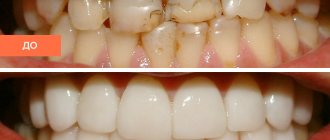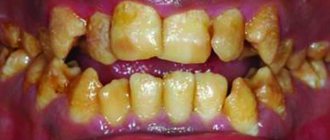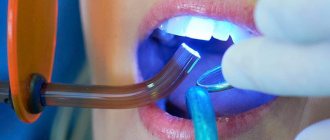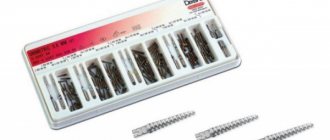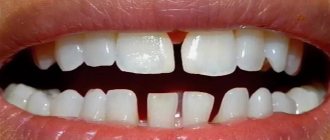The procedure involves the installation of modern, individually selected photopolymer fillings that are indistinguishable from natural teeth even by dentists. In St. Petersburg, the service is provided by the Nurimed clinic, where experienced doctors work who take on clinical cases of any complexity. You can make an appointment or clarify the information you are interested in by calling: +7 (965) 067-04-26, or via online chat.
Dental restoration with composite materials.
Dentistry is actively developing every year; people’s eternal desire for everything beautiful has motivated specialists to create new, more advanced technologies for dental treatment and restoration. Over time, a new direction called aesthetic dentistry has emerged, which deals with these issues. It provides the opportunity to correct various cosmetic defects, and composite materials allow you to recreate the structure of the tooth, its anatomical shape and color. If filling only restores the functionality of the unit, then during its restoration the appearance is corrected. Let's talk in more detail about this unique technique.
About the procedure.
The main objective of the cosmetic restoration procedure is to restore and adjust the size and shape of the tooth and also improve its appearance. With its help you can solve several problems:
- Easily eliminate the consequences of carious damage. During the treatment of caries, all infected tissues are drilled out, and in their place a cavity is formed, which must be filled with a filling. Thanks to composite materials, the defect can be corrected and the crown of the tooth can be successfully restored.
- Change the shade of enamel. Due to age-related changes, due to treatment and other things, the appearance of our smile noticeably deteriorates, and with the help of modern photopolymer materials you have the opportunity to return the natural shade of tooth enamel.
- Hide large interdental gaps. Composite restoration allows you to hide visible imperfections such as trema and diastema.
- Correct uneven units. During restoration, it is possible not only to eliminate cosmetic defects of the teeth, but also to correct some defects, for example, to give the desired shape to the front incisors. But before the procedure, you should definitely consult with an orthodontist, because... For serious pathologies, the only treatment option is braces.
- Fill in the missing part of the tooth. Due to injury or carelessness, a small piece of a person’s crown may break off. So that this deficiency does not cause inconvenience, it can be corrected by building up the missing part with a composite.
Cosmetic restoration is carried out using several methods, depending on what the patient wants and what problems he has, one of them is selected. To achieve an excellent effect, the A-medic clinic uses only high-quality composite materials, which allow you to achieve complete color similarity and look natural. This procedure is mainly used as the final stage of caries treatment; using a light-curing composite, the doctor restores the shape of the damaged tooth, recreating its crown part almost anew. This kind of work requires a professional who can take into account the anatomical features of the incisors, molars and canines and reproduce all the tubercles and irregularities on their chewing surface. If everything is done efficiently, the patient will not even be able to feel or touch the filling with his tongue.
Alternative options
If you are not satisfied with the aesthetic performance and fragility of composites, then you can consider other restoration options:
- Ceramic, zirconium or metal-ceramic veneers. Unlike composite ones, they are installed only indirectly. Ceramic overlays are more aesthetically pleasing and are indistinguishable from natural enamel in shade and transparency. Some microprostheses can last 10 - 15 years or more. However, the price of one veneer starts from 25,000 rubles, and ultra-thin plates can cost 2–3 times more.
- Ceramic or metal inlays. A more reliable alternative to composite on a pin, but also more expensive. Most often used on chewing teeth.
- Crowns. Indicated for use if the outer part of the tooth is severely damaged. They are made from different materials: zirconium dioxide, metal-free ceramics, metal ceramics. Durable, wear-resistant, last for many years.
Contraindications.
Composite restoration, although it belongs to the section of aesthetic dentistry, is still a medical procedure and has a number of absolute contraindications. It cannot be performed if the patient is allergic to the materials used, has acute gum disease and has numerous caries. There are also several relative contraindications that should also be kept in mind:
- Destruction of tooth tissue by more than half.
- Absence of outer molars.
- Bruxism (teeth grinding).
- Abrasion of teeth.
- Malocclusion.
Advantages and disadvantages
For aesthetic restoration of teeth, different materials are used: photocomposites, ceramics, metal-ceramics and others. You can hide defects under a crown or onlays. Each material and method has its pros and cons.
Advantages of composite restoration:
- the aesthetics and integrity of the dental unit are restored in just one visit to the doctor, there is no need to make impressions and wait several weeks for the manufacture of microprostheses;
- minimal tissue preparation without depulpation;
- the possibility of performing the procedure without anesthesia, which is important for patients with allergies to anesthetics;
- the method is available for the reconstruction of primary teeth in children for whom crowns or veneers are not recommended because the bite is disturbed;
- good aesthetics, strength, wear resistance;
- large selection of shades;
- the material is plastic, easy to model, and working with it is not limited in time;
- there is no rehabilitation period;
- possibility of repair if chipped;
- cheaper than installing ceramic or metal-ceramic veneers.
After 2 - 3 years, the restoration fades and loses its former attractiveness. Composites are quite porous, so they absorb food coloring. However, if you follow the rules of hygiene and exclude foods with food dyes or pigments from your diet, the results will last longer.
The service life of a photopolymer restoration is several times shorter than that of veneers, crowns made of non-matella ceramics or metal ceramics, which is also a significant disadvantage.
Features of composite dental restoration.
Composite materials have been used in dentistry for over 50 years. And every year their quality improves, they become more reliable and durable. During the restoration process, the composite bonds to the surface of the tooth, strengthening and restoring its integrity. In some cases, when the crown is almost half destroyed, this restoration method is even preferable. It allows you to avoid depulpation (removal of the nerve) and the unit will not need to be ground down for an artificial insert.
Nowadays, almost all specialists have begun to use photo-curable materials in their work; with their help, you can achieve excellent aesthetic results. Of course, such structures as veneers, inlays and crowns greatly simplify the adjustment process; you just need to glue them on and your smile is already transformed. In the case of composite restoration, the dentist selects the appropriate shade of the material, carefully recreates parts of the damaged tooth, not forgetting about its features, tubercles and fissures. But even taking this fact into account, this aesthetic dentistry service has a number of advantages:
- The procedure is performed in one step.
- Reasonable price.
- Subject to the dentist's recommendations and proper care, the appearance of the restored teeth will remain for a long time.
- If the patient is not satisfied with the result, the restoration can be redone.
- Minimal grinding of healthy tooth tissue.
Methods of dental restoration.
In dentistry, there are two options for aesthetic restoration. The indirect method is used in more complex cases where it is necessary to restore severely damaged units and correct serious cosmetic defects. In this case, the whole process is extended over several appointments: first, the doctor conducts an examination and takes impressions, and then sends them to the laboratory where the restoration elements will be made. Another technique is direct restoration, which involves the use of composite materials. All manipulations are carried out directly in the patient’s mouth, in the dentist’s office. Sometimes the procedure can last several hours, which causes discomfort for the patient. In case of more significant chips and destruction of the unit, to strengthen it and to secure the filling well, a pin is installed in the root canal.
Stages of composite restoration.
Let's take a closer look at the stages of direct dental restoration.
- Preparatory.
To begin with, the dentist will conduct an examination, assess the condition of the teeth and gums, and, if necessary, prescribe oral sanitation. In order for the color of the restored area to be identical to the natural one, it is necessary to clean the teeth of plaque and stone. Only after this can a specialist correctly determine the appropriate shade of the composite.
- Cleansing.
For a painless procedure, the patient is given an injection with anesthetic drugs. After the anesthesia begins to take effect, carious tissue, remnants of old fillings and other contaminants that may cause poor contact between the photopolymer and the crown are removed from the surface of the tooth.
- Tooth shape modeling.
The filling material is applied in layers, the dentist combines different shades of the composite, creating a natural shade. At the same time, he tries to recreate the appearance of a natural tooth, taking into account its anatomical features. At the end of the procedure, the chewing surface of the unit is polished and ground so that nothing disturbs the patient.
Types of composites
For direct restorations performed directly in the mouth, high-quality materials from Europe and the USA are used. Dental clinics in Moscow often use the very durable Filtek nanocomposite, the most aesthetically pleasing Venus, and a material with a large palette of Enamel Plus shades.
For indirect reconstruction, other composite materials are used. Veneers and inlays are created from an impression in the laboratory. Finished products are baked in an oven rather than hardened by exposure to light. In this case, the composite is used less often than ceramics or metal-ceramics.
Recommendations for care.
As soon as the specialist completes his work, you will be able to admire your irresistible smile, without any cosmetic defects. To maintain the results obtained for many years, you must follow a few simple rules. Their implementation will not be difficult for you at all, but at the same time your teeth will remain intact.
- Eliminate food and drinks containing dyes from your diet for a day after the procedure. In the future, also try to avoid consuming highly colored foods, carbonated water, red wine, coffee, etc.
- Don't forget about regular dental checkups and professional oral hygiene.
- On the first day after restoration, women should not wear bright red lipstick.
- The restored areas of the teeth may not withstand heavy loads, so you should not bite seeds, nuts, or chew sticky food.
- Use a toothbrush with soft bristles; it will avoid rapid abrasion of the filling material.



